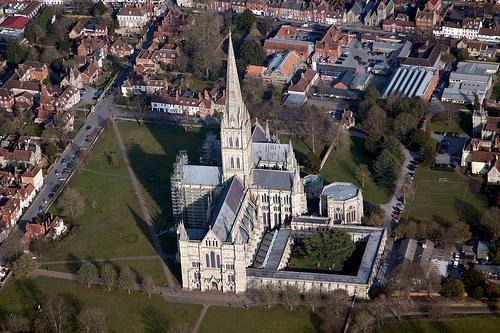This is the sixth and final part. To read the complete article go here.
Architecture
Recently I was given a explanation of the design of the gothic cathedral at Salisbury in England in which it was pointed out that it was unusual for a non-monastic church to have a covered cloister. It was there, I was told because of the special nature of the Sarum liturgy, which originated in Salisbury (Sarum being the old name for Salisbury). It had many processions and the cloister was the place of procession – a covered walkway built with the English rain in mind! It occurred to me that as liturgical action develops so as to engage art, this will not only effect the style of art, the content of the images and the combination of images we see in churches, it will also affect the architecture of newly built churches just as the Sarum liturgy affected the design of this gothic cathedral. Perhaps if processions are the way, we might see a re-emergence of the cloister or covered walkway. then we could have a planted garden of Eden in the quadrangle. People would see it as they proces into the church where they will be greeted with a pictorial, architectural and musical rendition of the New Jerusalam and paradise restored. Alternatively we might see new but liturgically authentic architectural developments that characterize our age that are previously unimagined.
For those who are interested in knowing more, the curriculum of Pontifex University’s Masters in Sacred Arts is designed with these principles in mind. The Pontifex MSA gives its students the scripture knowledge and understanding of liturgical principles in relation to visual imagery by which, we hope, the new schema will emerge.
Appendix: existing guidelines on art.
The GIRM
318. In the earthly Liturgy, the Church participates, by a foretaste, in that heavenly Liturgy which is celebrated in the holy city of Jerusalem, toward which she journeys as a pilgrim, and where Christ is seated at the right hand of God; and by venerating the memory of the Saints, she hopes one day to have some share and fellowship with them.[131] Thus, in sacred buildings images of the Lord, of the Blessed Virgin Mary, and of the Saints, in accordance with most ancient tradition of the Church, should be displayed for veneration by the faithful[132] and should be so arranged so as to lead the faithful toward the mysteries of faith celebrated there. Care should, therefore, be taken that their number not be increased indiscriminately, and moreover that they be arranged in proper order so as not to draw the attention of the faithful to themselves and away from the celebration itself.[133] There should usually be only one image of any given Saint. Generally speaking, in the ornamentation and arrangement of a church, as far as images are concerned, provision should be made for the devotion of the entire community as well as for the beauty and dignity of the images.
Canon Law re Sacred Images, 1186-1190, here.
In the US: Built in the Living Stone., Chapter Three

